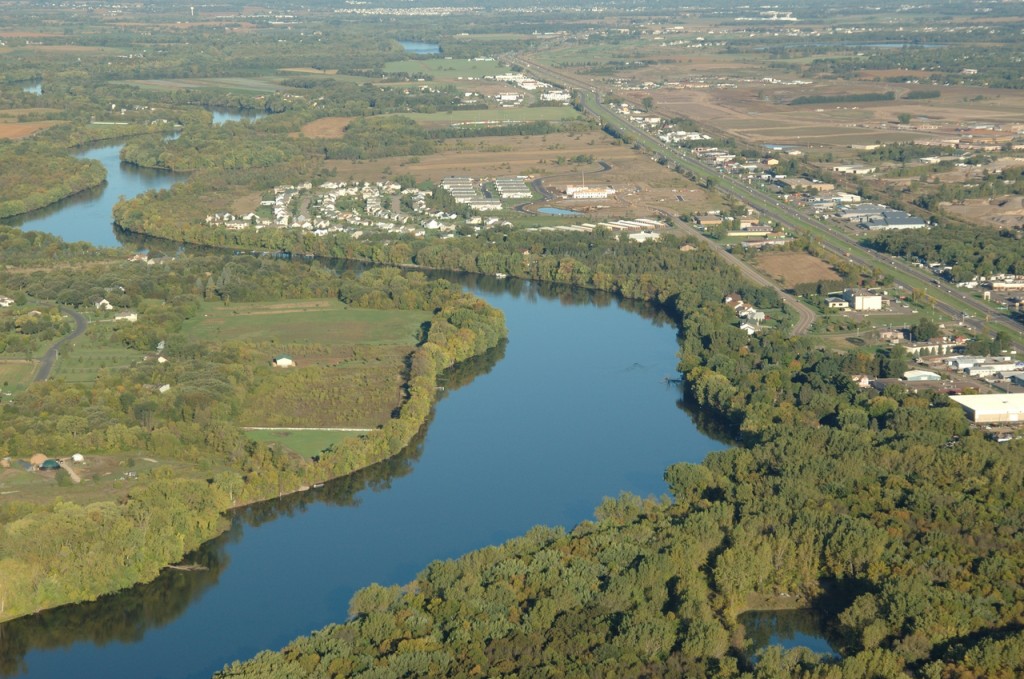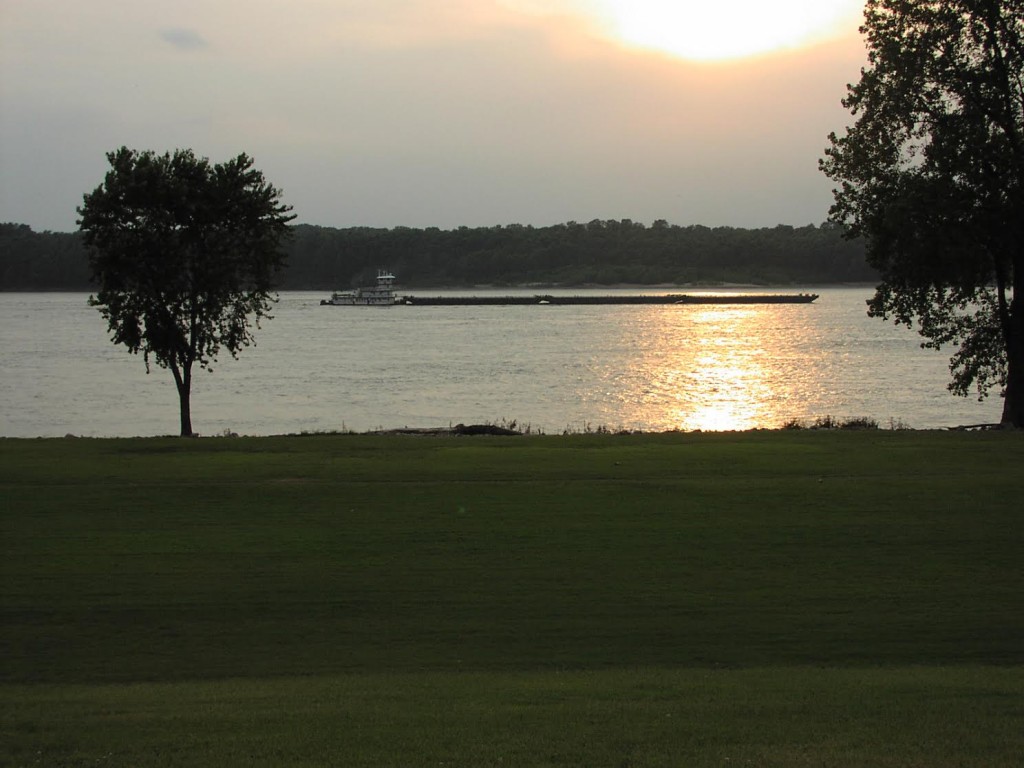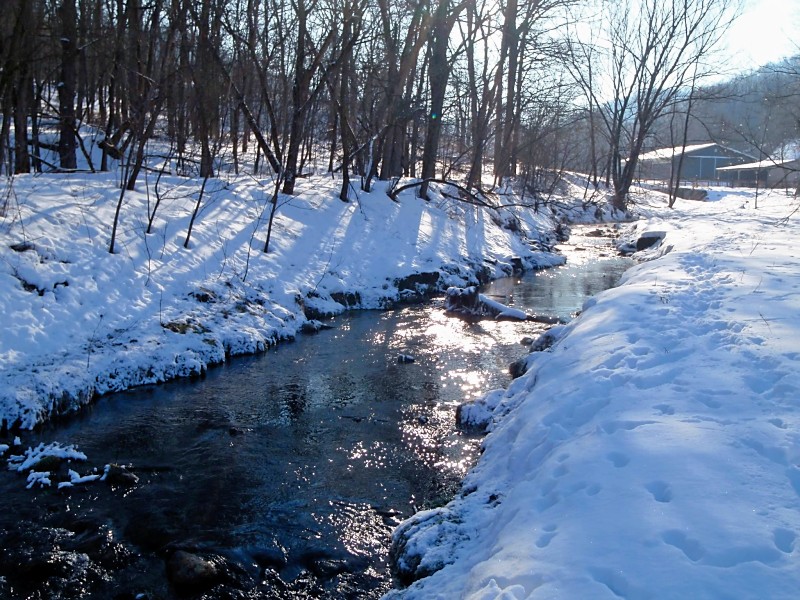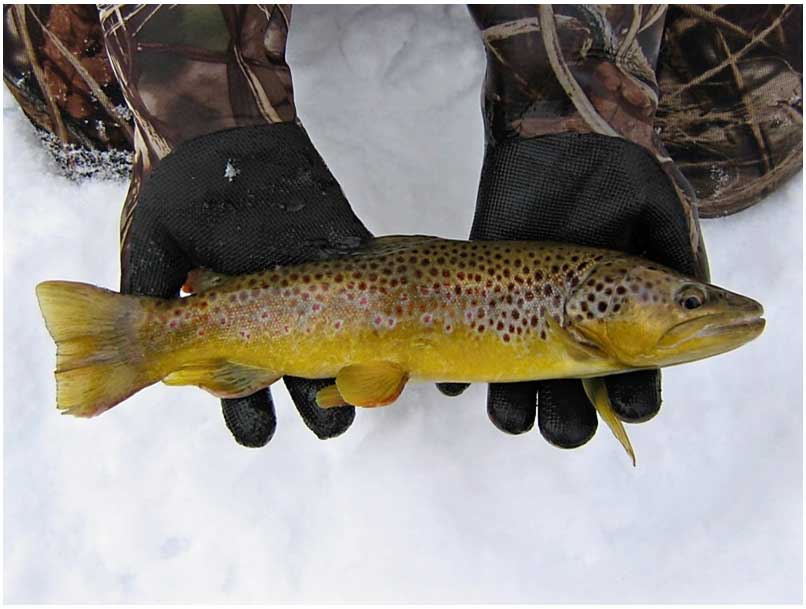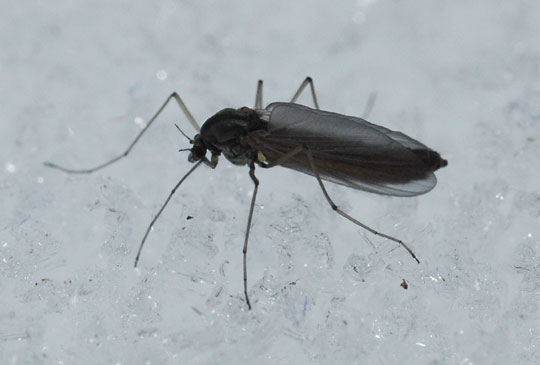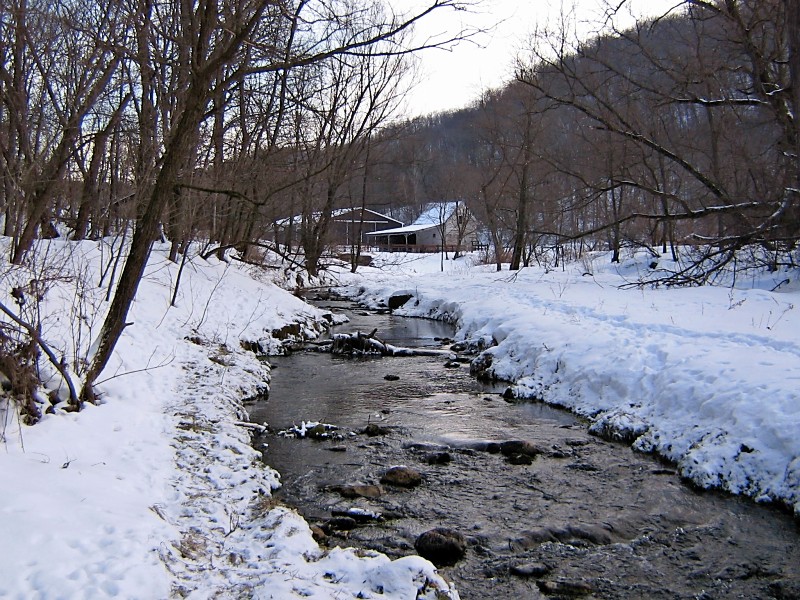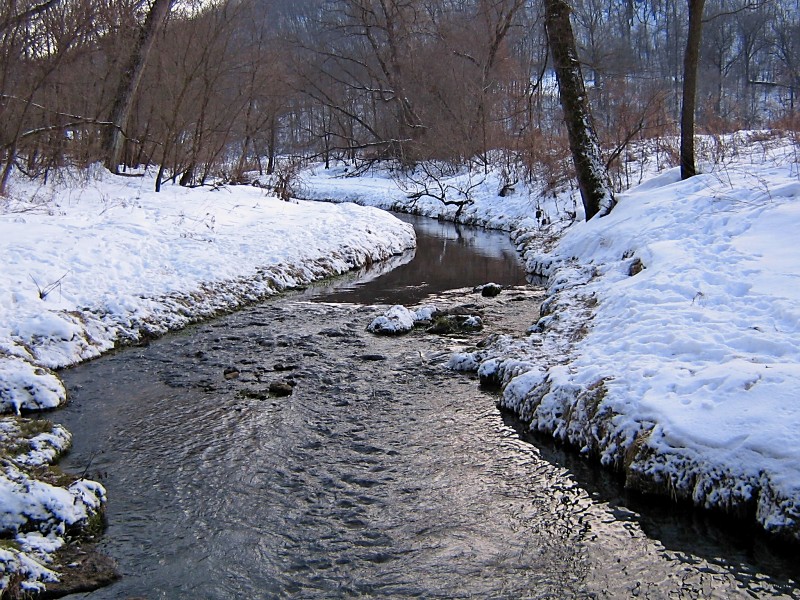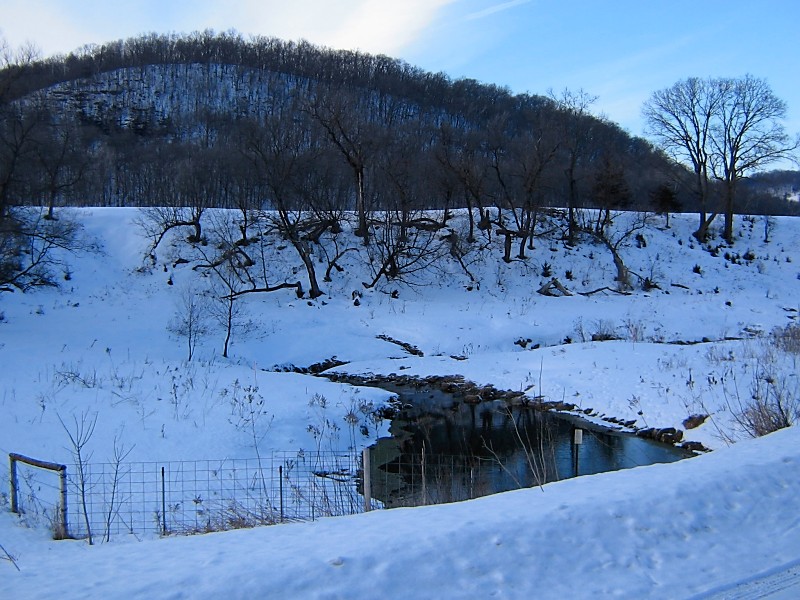Interdisciplinary
By Jane Mazack
Exploring Daley Creek is a blog series that investigates the biological and physical processes at work in a small stream in Minnesota and what it means to consider rivers in a scientific framework. Follow along to learn more about life in the stream and its broader connections, both in the present and as we consider a future of climate change.
“Rivers have the power to connect us.” This opening statement by the University provost caught my attention. It was the reason that we were all here – the Mississippi River. That common thread was apparent throughout the diverse discussions of “The Once and Future River” symposium, which included scientists, historians, Native scholars, artists, and community leaders.
Mississippi River. Photo from the Institute for Advanced Study, UMN, all rights reserved.
River relationships are complex; they encompass the human and the non-human, the objective and the conjectured, data and narratives, and history and the future. Daley Creek is not only defined by its ecology, but also by its hydrology and geology, and also by its history and community stories.
Last week’s symposium brought people together by their common relationship with the Mississippi River. At the same time, it celebrated the diversity in perspectives, stories, and understandings that were brought together. This wide-ranging expertise presents the opportunity for collaborative discussions and solutions – ones that would not be possible without interdisciplinary voices.
When we think of interdisciplinary work, we often think of two closely related fields: geology and ecology, or anthropology and history. But what if we thought of interdisciplinary work as something bigger? What if it spans the humanities and the sciences, the academic and the community, the once and the future? How do we talk with each other, rather than past each other? Where do we go from here?
The writing and analysis of this blog series were conducted under the auspices of the John E. Sawyer Seminar “Making the Mississippi: Formulating New Water Narratives for the 21st Century”. Sawyer seminars are funded by the Andrew Mellon Foundation; further information about “Making the Mississippi” can be found here.
The once and future river
By Jane Mazack
Exploring Daley Creek is a blog series that investigates the biological and physical processes at work in a small stream in Minnesota and what it means to consider rivers in a scientific framework. Follow along to learn more about life in the stream and its broader connections, both in the present and as we consider a future of climate change.
Over the past two months, we’ve been exploring Daley Creek by considering its geologic past, ecologic present, and climate-driven future. Each of these parts is essential — but it’s also important that we consider this stream as part of a larger whole. Daley Creek lies within the Mississippi River watershed; the water that flows through this small stream is only at the beginning of a long, winding journey.
Mississippi River. Photo from the Institute for Advanced Study, UMN, all rights reserved.
This week, the John E. Sawyer Seminar at the University of Minnesota will be considering the past, present, and future of the Mississippi River. We’ll be exploring what it means to “know” or “understand” the river, and what traditions, narratives, and histories can help us move forward in living with the river.
The symposium kicks off tomorrow night with a keynote by Jim Rock, a local Dakota scholar and educator. Throughout the day on Thursday and on Friday morning, panel discussions will consider the Mississippi River in its multi-faceted roles as Frame, Place, Water, and Future. We expect that the wide-ranging discussions and insights gained here will be only the beginning of ongoing conversations and growth.
No matter where you may be located within your watershed – a small headwater stream, an urban river, a sprawling delta – your place is but a part of a larger whole. In our case, that whole is the Mississippi River. If your place is near or in the Twin Cities, consider joining us for some or all of the discussions this week as we explore “The Once and Future River”.
The writing and analysis of this blog series were conducted under the auspices of the John E. Sawyer Seminar “Making the Mississippi: Formulating New Water Narratives for the 21st Century”. Sawyer seminars are funded by the Andrew Mellon Foundation; further information about “Making the Mississippi” can be found here.
So what about climate change?
By Jane Mazack
Exploring Daley Creek is a blog series that investigates the biological and physical processes at work in a small stream in Minnesota and what it means to consider rivers in a scientific framework. Follow along to learn more about life in the stream and its broader connections, both in the present and as we consider a future of climate change.
What you see may not stay the same. Ecosystems are dynamic; they are changing, reacting, and interacting systems. And while climate change is a global issue, it’s also essential to consider and understand its local implications. Current and future climate changes will significantly impact southeastern Minnesota streams like Daley Creek.
Daley Creek, Houston County, Minnesota. Photo by the author, all rights reserved.
In the short term, increases in air temperature directly increase water temperature via heat exchange. Predicted climate change scenarios estimate that air temperatures in the midwestern United States may rise between 1 and 8°C by the year 2050. In the long term, a warmer climate will also raise the temperature of groundwater. In fact, below-ground temperatures near Saint Paul, Minnesota have already risen nearly 2°C over the past several decades (37 years of historical data1).
Trout and cold-adapted insect populations in southeastern Minnesota streams will be vulnerable to climate changes. Midges such as Diamesa mendotae that complete multiple generations over a single winter may not be able to successfully complete multiple generations if water temperatures rise above their preferred thermal range.
This potential reduction in available invertebrate biomass may exacerbate significant declines in trout populations.Climate change models developed for Wisconsin predict that a 5°C increase in air temperature would eliminate 100% of brook trout and 88% of brown trout distribution across the state2. By identifying stream reaches that may be the most vulnerable to climate changes we can thoughtfully prioritize management and restoration projects.
1 Baker and Baker. 2002. Long-term ground heat flux and heat storage at a mid-latitude site. Climatic Change 54:295-303.
2 Mitro, Lyons, and Stewart. 2010. Predicted effects of climate change on the distribution of wild brook trout and brown trout in Wisconsin streams. In: Carline and LoSapio (Eds.), Proceedings of the Wild Trout X Symposium pp. 69-76.
The writing and analysis of this blog series were conducted under the auspices of the John E. Sawyer Seminar “Making the Mississippi: Formulating New Water Narratives for the 21st Century”. Sawyer seminars are funded by the Andrew Mellon Foundation; further information about “Making the Mississippi” can be found here.
The circle of life
By Jane Mazack
Exploring Daley Creek is a blog series that investigates the biological and physical processes at work in a small stream in Minnesota and what it means to consider rivers in a scientific framework. Follow along to learn more about life in the stream and its broader connections, both in the present and as we consider a future of climate change.
If you examine the stomach contents of a brown trout from Daley Creek, you’ll most likely find midges. If there’s an emergence event occurring, you’ll most likely find hundreds of midges – a pupal midge, floating to the water’s surface, is an easy and tasty target for a hungry fish.
Brown trout. Photo by the author, all rights reserved.
Groundwater-fed streams like Daley Creek provide ideal habitat for trout. Brook and brown trout rely on aquatic insects as a primary component of their diet, especially when winter conditions reduce terrestrial stream inputs.
Cold-adapted midges are relatively abundant in the winter, and as such, are common prey items in trout diets. But you’ll also find other insects in Daley Creek and in trout diets. Caddisfly, mayfly, and stonefly larvae are all common in groundwater-fed streams.
But what do these insects eat? While some insects are predators, many species rely on plant material for the bulk of their diets, and are often characterized by their feeding methods. “Shredders”, including some stoneflies, break down large plant and leaf material that falls into the stream. Just downstream, caddisflies, black flies, and others attach themselves to rocks on the stream bed, waiting to filter the resultant fine particulate material.
In contrast, snails and beetles are often characterized as grazers. They, unlike shredders, feed primarily on in-stream plant sources like algae, which covers rocks. This diversity of resource utilization, and diversity of insect species, is what makes Daley Creek healthy. Without a stable base to their food web, trout populations are less resistant to disturbance and more vulnerable to harsh conditions.
The writing and analysis of this blog series were conducted under the auspices of the John E. Sawyer Seminar “Making the Mississippi: Formulating New Water Narratives for the 21st Century”. Sawyer seminars are funded by the Andrew Mellon Foundation; further information about “Making the Mississippi” can be found here.
An uncharismatic microfauna?
By Jane Mazack
Exploring Daley Creek is a blog series that investigates the biological and physical processes at work in a small stream in Minnesota and what it means to consider rivers in a scientific framework. Follow along to learn more about life in the stream and its broader connections, both in the present and as we consider a future of climate change.
When you hear about the implications of climate change, they’re often accompanied by a heart-tugging picture of a polar bear on a tiny sliver of ice. This setup is designed to capture your emotions and gain popular appeal. Polar bears, like elephants, lions, and pandas, are charismatic megafauna; they’re large animals that catch humans’ attention.
L to R: Polar bear; giant panda; male adult midge (Species: Diamesa mendotae). Midge photo by the Chironomid Research Group, all rights reserved.
But environmental issues like climate change don’t just affect charismatic megafauna — and that’s why they are such important issues. They affect all aspects of ecosystems, from the largest species, like polar bears, to the smallest species, like midges.
The midge populations in Daley Creek are dependent on its seasonal water temperature patterns. Diamesa mendotae, a cold-adapted species of midge, only grows and develops for the few months when water temperatures are below 50°F; eggs laid in the spring are dormant all summer and only begin to grow when water temperatures drop again in the fall. Therefore, shifts in temperature patterns may cause dramatic shifts in midge growth and development.
This relatively “uncharismatic microfauna” is a key part of Daley Creek’s ecosystem. Midges aren’t large, cuddly, or fuzzy (except for their antennae), but they’re still important. The health and function of an ecosystem is a consequence of all its parts, not just its charismatic megafauna.
The writing and analysis of this blog series were conducted under the auspices of the John E. Sawyer Seminar “Making the Mississippi: Formulating New Water Narratives for the 21st Century”. Sawyer seminars are funded by the Andrew Mellon Foundation; further information about “Making the Mississippi” can be found here.
Why you shouldn’t kill mosquitoes in January
By Jane Mazack
Exploring Daley Creek is a blog series that investigates the biological and physical processes at work in a small stream in Minnesota and what it means to consider rivers in a scientific framework. Follow along to learn more about life in the stream and its broader connections, both in the present and as we consider a future of climate change.
On a cold but sunny January day in southeastern Minnesota, you may see a strange sight: thousands of insects emerging from the waters of Daley Creek, walking upon its snowy banks, and swarming in the chilly air. If you look closely, you’ll notice that they look a bit like mosquitoes, but with one important distinction – they have no proboscis, and so they cannot bite you. These cold-adapted flies are chironomids, also known as midges.
Female adult midge on snow (Species: Diamesa mendotae). Photo by the Chironomid Research Group, all rights reserved.
Each adult midge began its life cycle as an egg in the streambed of Daley Creek. When water temperatures fell below 10°F in the fall, the egg began to grow and develop. Over the next two months, it completed four larval stages, pupated, rose to the surface of the water, and emerged as an adult – groundwater from the Karst limestone prevented the water from freezing. The newly emerged adult crawled up the snowy bank in sub-freezing January weather, where she found a mate. The eggs she laid will begin a second generation, which will be completed as winter turns to spring.
So, if you’re in Minnesota and you think you see a mosquito in January, think again. It may not be a mosquito at all.
The writing and analysis of this blog series were conducted under the auspices of the John E. Sawyer Seminar “Making the Mississippi: Formulating New Water Narratives for the 21st Century”. Sawyer seminars are funded by the Andrew Mellon Foundation; further information about “Making the Mississippi” can be found here.
Where is your place?
By Jane Mazack
Exploring Daley Creek is a blog series that investigates the biological and physical processes at work in a small stream in Minnesota and what it means to consider rivers in a scientific framework. Follow along to learn more about life in the stream and its broader connections, both in the present and as we consider a future of climate change.
As you’ve been reading this blog series, I’ve encouraged you to imagine yourself at Daley Creek in southeastern Minnesota, because the stories I’ve been telling are centered around its place. Its glacial history and groundwater inputs are a result of its specific location. Its fish and insect populations are unique, even from the ones in a stream less than five miles away.
Daley Creek, Houston County, Minnesota. Photo by the author, all rights reserved.
But this is my place; it may not be your place.
Your place may be the Mississippi River, which does freeze in the winter.
Your place may be an estuary in Costa Rica, where January is dry rather than cold.
Your place may be Minnehaha Creek, which runs through your backyard.
Where is YOUR place? No matter where you are, you are somewhere — and that’s worth examining. Are there streams nearby? What do you notice about them? What questions do you have?
Your place has a story, and knowing and living in that story are essential to understanding the world where you live. Being a part of the story of your place means respect, care, and consideration are paramount in the way you live. Because your place isn’t just a place, and your story isn’t just about you. So, where is your place? And what does that mean for you?
The writing and analysis of this blog series were conducted under the auspices of the John E. Sawyer Seminar “Making the Mississippi: Formulating New Water Narratives for the 21st Century”. Sawyer seminars are funded by the Andrew Mellon Foundation; further information about “Making the Mississippi” can be found here.
Why Daley Creek doesn’t freeze
By Jane Mazack
Exploring Daley Creek is a blog series that investigates the biological and physical processes at work in a small stream in Minnesota and what it means to consider rivers in a scientific framework. Follow along to learn more about life in the stream and its broader connections, both in the present and as we consider a future of climate change.
It’s winter in Minnesota — and that means cold, snow, and ice. But if you visit Daley Creek in southeastern Minnesota, you’ll see that despite the cold weather, the water in the stream is not frozen. Do you know why?
Daley Creek, Houston County, Minnesota. Photo by the author, all rights reserved.
Last week, I talked about how Daley Creek has twisted and turned its way through a deeply carved valley. That erosion has brought the stream down through multiple geologic strata. Each of these layers was laid down at a different time in history, and so they have different compositions.
The strata that Daley Creek flows through are made of sandstone and limestone. These rock formations contain groundwater in their pores and fractures; this water originates from surface water percolating down into the ground, but it remains underground for a relatively long period of time. Over time, groundwater equilibrates to the mean annual air temperature — around 9°C (48°F) in this area.
When groundwater enters a stream in the winter, it warms the water, preventing it from freezing. The effect is opposite in the summer – groundwater cools the stream’s temperature. In both cases, the temperature of the groundwater is less extreme than the temperature of surface water. As a result, Daley Creek has a narrower temperature range than surface-water fed streams.
Groundwater-fed streams, which remain ice-free in winter and cool in summer, provide ideal habitat for trout and winter-adapted insects… stay tuned!
The writing and analysis of this blog series were conducted under the auspices of the John E. Sawyer Seminar “Making the Mississippi: Formulating New Water Narratives for the 21st Century”. Sawyer seminars are funded by the Andrew Mellon Foundation; further information about “Making the Mississippi” can be found here.
An ancient landscape
By Jane Mazack
Exploring Daley Creek is a blog series that investigates the biological and physical processes at work in a small stream in Minnesota and what it means to consider rivers in a scientific framework. Follow along to learn more about life in the stream and its broader connections, both in the present and as we consider a future of climate change.
When you drive along the Mississippi River in southeastern Minnesota, one of the first things you notice is the topography. Each side of the river is flanked with plateaus and carved with valleys. Daley Creek is nestled within one of these valleys. It twists and turns through farms and fields, flowing into the Root River where it joins in a 25 mile journey to the Mississippi River itself. But this journey doesn’t just go back 25 miles – it goes back tens of thousands of years to its (lack of) glacial history.
Daley Creek, Houston County, Minnesota. Photo by the author, all rights reserved.
As you travel up the valley, you travel back in history. The most recent Ice Age glaciated much of the Midwestern United States. When the final glaciers melted and receded, they left behind a glacial drift of silt, sand, gravel, and boulders – a new, untouched landscape.
But in the midst of this new landscape remains an old landscape. Daley Creek and the surrounding area weren’t glaciated and weren’t covered with glacial drift. This “Driftless Area” encompasses southeastern Minnesota, along with southwestern Wisconsin and portions of Iowa and Illinois.
This ancient landscape is characterized by deeply-eroded channels. Years and years of stream flow have carved a path through the surface of the land, creating deep valleys among hills and plateaus. The present form of Daley Creek is just a moment of its long history as it continues its future journey. This history is what makes Daley Creek unique; join us next week to learn how the landscape dramatically impacts the stream in the winter.
The writing and analysis of this blog series were conducted under the auspices of the John E. Sawyer Seminar “Making the Mississippi: Formulating New Water Narratives for the 21st Century”. Sawyer seminars are funded by the Andrew Mellon Foundation; further information about “Making the Mississippi” can be found here.
What do you see?
By Jane Mazack
Exploring Daley Creek is a blog series that investigates the biological and physical processes at work in a small stream in Minnesota and what it means to consider rivers in a scientific framework. Follow along to learn more about life in the stream and its broader connections, both in the present and as we consider a future of climate change.
Imagine on this February morning that you’re standing alongside Daley Creek in southeastern Minnesota. It’s a chilly 12°F, and your breath fogs in the morning air. You look around and see the following scene:
Daley Creek, Houston County, Minnesota. Photo by the author, all rights reserved.
But what exactly do you see?
You may see that despite the cold weather, the water in the stream is not frozen. But you may not know why.
You may see a farm in the background. But you may not be aware how that affects the stream.
You may see animal tracks lining the snowy banks of the stream. But you may not realize that there are hundreds of fish and tens of thousands of aquatic insects living in the stream itself, even in the depths of winter.
Even this very small stream is full of complexity. It’s a product of natural history and cultural history; of watershed and ecology; of fish and insects; of past, present, and future. Climate change complicates this natural world in ways we need to understand. How is Daley Creek already being affected by climate changes? How will it change in the future?
In order to address this broad and complex issue, we need to begin by answering specific questions: how do its geological, hydrological, and ecological components make Daley Creek what it is today? Only by understanding the past and present can we begin to look at the future in the midst of a changing climate. Follow along with us in this blog series as we consider these questions in an effort to more fully and scientifically understand the river.
The writing and analysis of this blog series were conducted under the auspices of the John E. Sawyer Seminar “Making the Mississippi: Formulating New Water Narratives for the 21st Century”. Sawyer seminars are funded by the Andrew Mellon Foundation; further information about “Making the Mississippi” can be found here.
